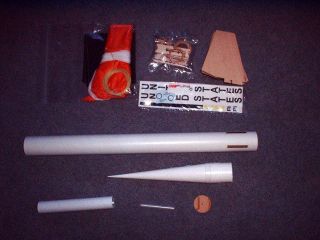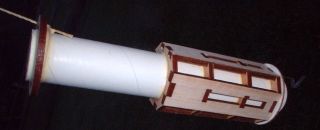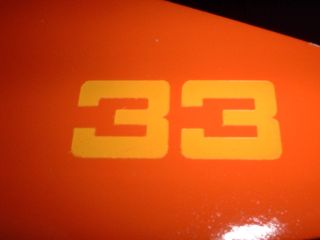| Construction Rating: | starstarstarstarstar |
| Flight Rating: | starstarstarstarstar_border |
| Overall Rating: | starstarstarstarstar |
| Manufacturer: | Qmodeling  |

Brief:
A great 2.2x upscale of the 1970's Estes classic that is capable of flying to
nearly 1000 feet on 24mm motors.
Construction:
Parts were tightly packed in a plastic bag with a header card showing
handwritten production number. Despite tight packing, there was no problem at
all with component quality. Parts list includes:
- Cast resin nose cone
- BT-60 body tube
- 4 Laser cut balsa fins
- 24mm foil-lined motor tube
- Motor mount/centering ring assembly
- 9" x 9" Nomex® heat shield
- 30" Top Flight ripstop nylon chute
- Kevlar® shock cord
- Water slide decals
- 3/16" launch lug
The Qmodeling instructions are very good and include plenty of illustrations. An added touch is that they're broken down into sections with estimated times, so you can plan the construction out around your real life, without having to worry about being in the middle of a tricky assembly when it's time to haul the kids off to the latest event.
 Construction
starts with the motor mount assembly. If you're not familiar with Qmodeling
mounts, this will be a bit of a challenge as they are much more complicated
than usual. The assembly consists of a series of mounting rings carefully
spaced along the motor tube followed by balsa fin braces that support location
of through the wall fin mounting. These are very precisely cut parts and fit
very well but you need to be especially careful about the alignment of the
parts for correct placement of fins and the motor tube. Once everything is
glued together, the assembly finishes up by tying/gluing the Kevlar®
shock cord to the motor tube.
Construction
starts with the motor mount assembly. If you're not familiar with Qmodeling
mounts, this will be a bit of a challenge as they are much more complicated
than usual. The assembly consists of a series of mounting rings carefully
spaced along the motor tube followed by balsa fin braces that support location
of through the wall fin mounting. These are very precisely cut parts and fit
very well but you need to be especially careful about the alignment of the
parts for correct placement of fins and the motor tube. Once everything is
glued together, the assembly finishes up by tying/gluing the Kevlar®
shock cord to the motor tube.
 Sanding/sealing
of the 4 fairly large fins can take some time but is worth the effort. Once
prepped, the fins are then bonded to the motor tube through the wall and
fillets applied along the body tube. The fit was perfect and alignment is not
an issue with the fin braces.
Sanding/sealing
of the 4 fairly large fins can take some time but is worth the effort. Once
prepped, the fins are then bonded to the motor tube through the wall and
fillets applied along the body tube. The fit was perfect and alignment is not
an issue with the fin braces.
Construction finishes up by attaching the launch lug and prepping the nose cone. Note that the dimension listed for placement of the launch lug is incorrect and would result in decal and paint problems. Rather than the recommended 5 9/16" from tube bottom placement, I would suggest at least 7" or 7-1/2" placement.
The nose cone retention appears flimsy, consisting of simply CA'ing a wooden disk into the bottom of a resin nose cone and then gluing in a screw eye, but I've built 5 assorted Qmodeling kits and never had one fail.
Finishing:
For the finish, I filled the tube spirals with Elmers Fill 'n' Finish, then
went with two coats of Plasti-Cote gray primer, sanding in between. The result
is a completely spiral-free finish. I then followed up with the standard paint
scheme of gloss white body, gloss black nose cone, and orange base/fins.
 The kit I received
came with waterslide decals, including one with a bright yellow "33"
for two of the fins. Against the orange paint, the yellow decal was practically
invisible. The instructions referenced a stencil which could be used to paint
on the "33", but I didn't seem to get one. It turns out that the
stencil was held up in development and when I inquired about it, I promptly
received a couple of adhesive stencils fresh out of the test lab. These
stencils are laser cut Avery adhesive labels. They are custom cut to fit the
fin and the "33" is burned just enough to cut through the label
without tearing through the backing. I could then stick the label to the fin,
and pull away the "33" portion, exposing the area for painting. The
result was a perfect, crisp masking job, and the best idea I've ever seen for a
stencil!
The kit I received
came with waterslide decals, including one with a bright yellow "33"
for two of the fins. Against the orange paint, the yellow decal was practically
invisible. The instructions referenced a stencil which could be used to paint
on the "33", but I didn't seem to get one. It turns out that the
stencil was held up in development and when I inquired about it, I promptly
received a couple of adhesive stencils fresh out of the test lab. These
stencils are laser cut Avery adhesive labels. They are custom cut to fit the
fin and the "33" is burned just enough to cut through the label
without tearing through the backing. I could then stick the label to the fin,
and pull away the "33" portion, exposing the area for painting. The
result was a perfect, crisp masking job, and the best idea I've ever seen for a
stencil!
The water slide decals were very good, although I found they are the type that doesn't agree with Krylon clear coat, so I wound up having to replace them. (The first batch crazed badly.)
Construction Rating: 5 out of 5
Flight:
The maiden flight was on clear day with winds of 4-6 mph and I chose a D12-3,
fearing the 30" chute would cause too much drift. The Rogue climbed a
beautifully straight path although it spun just a bit on the way up (indicating
a slight fin cant and less than perfect motor mount assembly job). The 3-second
delay proved a bit early and the Kevlar®
line got tangled pretty badly, catching the chute lines. With only a partial
chute deployment, it came down fairly hard but landed in tall, soft grass and
was recovered without any damage.
For the second flight I went with a 5-second delay, which was a bit too long. Comparing the two, I'll stick with the 3 second delay as it will be less likely to zipper. Recovery on the second one was much better though, as I moved the chute attachment closer to the nose cone (roughly 2/3 of the way along the line).
Recovery:
The Nomex®/Kevlar®/nylon
chute recovery package is as good as it gets in modrocs, but is overkill for
this rocket. I'd go down to an 18" chute, and a 4" x 4" Nomex®
shield for this size tube. The 9x9 is simply too large and poses a risk of
blocking chute deployment.
Flight Rating: 4 out of 5
Summary:
This is an outstanding upscale and a terrific kit.
Overall Rating: 5 out of 5
Other Reviews
- Qmodeling Rogue By Bill Eichelberger (June 13, 2007)
Brief: The Estes Rogue on steroids! Same great looks but little chance that you can fly this one from your local athletic field. I won this for participating in an EMRR contest and started building it immediately. This is my third Rogue, the first being a BT-55 upscale and the second a 1:1 clone. Construction: The parts list: Nose cone Nose cone plug Eye hook ...
 |
 |
Flights
 |
 |
 |
 |
M.A.G. (December 17, 2008)